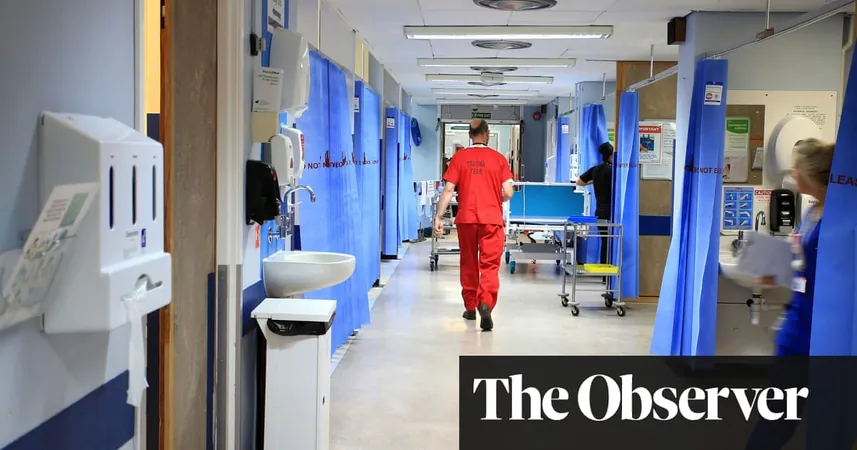
A Shocking 95.7% of Stroke Patients in England Miss Out on Life-Saving Treatment – What You Need to Know!
2024-09-29
Newly released data reveals a distressing reality for stroke patients in England: a mere 4.3% have access to the life-saving procedure known as mechanical thrombectomy, which can significantly reduce the impact of a stroke. This troubling statistic highlights a critical gap in healthcare access, as experts estimate that at least 10% of stroke sufferers could benefit from the procedure.
Mechanical thrombectomy involves the use of a wire and stent, expertly navigated to the brain to retrieve clots obstructing blood flow. The advantages of this intervention are considerable; not only does it mitigate serious disabilities, but in optimal cases, patients can walk out of the hospital as soon as the following day.
Data compiled by the Sentinel Stroke National Audit Programme (SSNAP) from King’s College London indicates that during the first quarter of this year, only a fractional percentage of stroke patients in England received this potentially life-altering treatment. This is particularly alarming, considering the urgency of timely intervention, as approximately two million brain cells perish each minute while blood flow is obstructed.
Peter Hooper, who received mechanical thrombectomy following a stroke in June 2020, voiced his concerns, stating, “It’s terrifying that people who could have the procedure and regain their independence are unable to access it.” He emphasizes the necessity for quick access to treatment for eligible patients.
At a recent awareness event in Stoke-on-Trent, NHS England medical director Prof Sir Stephen Powis acknowledged the setbacks induced by the COVID-19 pandemic on the rollout of mechanical thrombectomy. However, he assured attendees that the NHS is dedicated to expanding access. "It’s one of the most effective clinical interventions in medicine," he mentioned, describing the transformative potential of the procedure. Many patients, he noted, can leave their hospital stays remarkably quickly after receiving it.
While some hospitals, such as the University Hospitals of North Midlands, have successfully exceeded the target of treating 10% of stroke patients, the overall picture remains bleak across the country. Dr. Sanjeev Nayak, a specialized consultant in interventional neuroradiology at the same hospital, echoed the call for more resources to ensure broader access to the treatment. “Timing is crucial; when performed promptly, we can prevent permanent disabilities or even fatalities. The effect can be like a light switch, reviving brain function and enabling rapid recovery,” he explains.
Despite a long-term plan initiated by the NHS in 2019 aiming to treat 10% of stroke patients with mechanical thrombectomy by 2022, this goal has not been met, and treatment availability is inconsistent across regions. Alarmingly, reports emerged last year of tragic cases, including a primary school teaching assistant who suffered a stroke and was denied the crucial treatment during weekends.
Regional disparities are evident, with SSNAP data from April 2023 to March 2024 indicating thrombectomy rates as low as 1.7% in West Yorkshire and Harrogate, compared to a more encouraging 8.7% in Thames Valley. Nevertheless, the overall total of procedures performed in England saw a significant increase from 2,684 in 2022/23 to 3,501 in 2023/24, representing a 30% rise.
As the healthcare system grapples with these challenges, it raises essential questions about the future of stroke care and access to life-saving treatments in England. With advocacy and awareness, there is potential for change—ensuring more lives are saved and more patients are able to reclaim their independence after a stroke. Stay informed and advocate for better healthcare access!


 Brasil (PT)
Brasil (PT)
 Canada (EN)
Canada (EN)
 Chile (ES)
Chile (ES)
 España (ES)
España (ES)
 France (FR)
France (FR)
 Hong Kong (EN)
Hong Kong (EN)
 Italia (IT)
Italia (IT)
 日本 (JA)
日本 (JA)
 Magyarország (HU)
Magyarország (HU)
 Norge (NO)
Norge (NO)
 Polska (PL)
Polska (PL)
 Schweiz (DE)
Schweiz (DE)
 Singapore (EN)
Singapore (EN)
 Sverige (SV)
Sverige (SV)
 Suomi (FI)
Suomi (FI)
 Türkiye (TR)
Türkiye (TR)